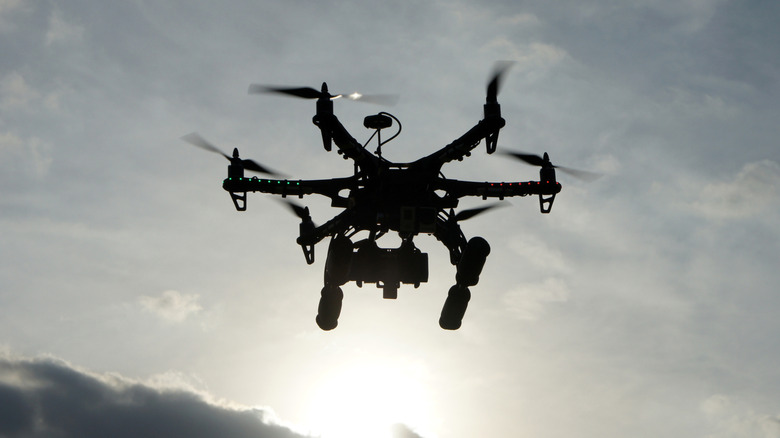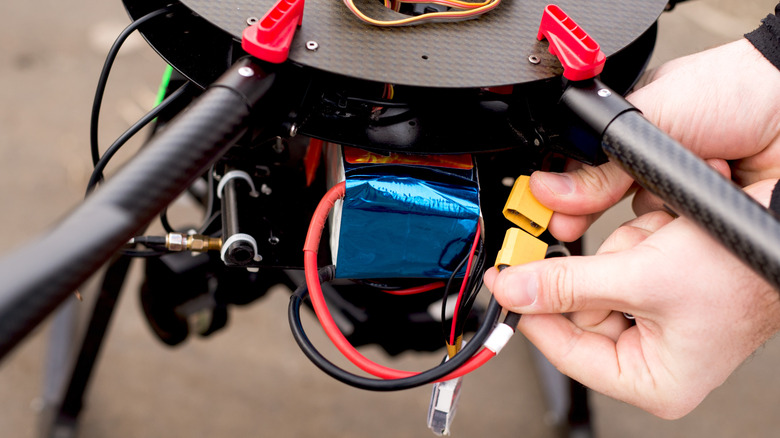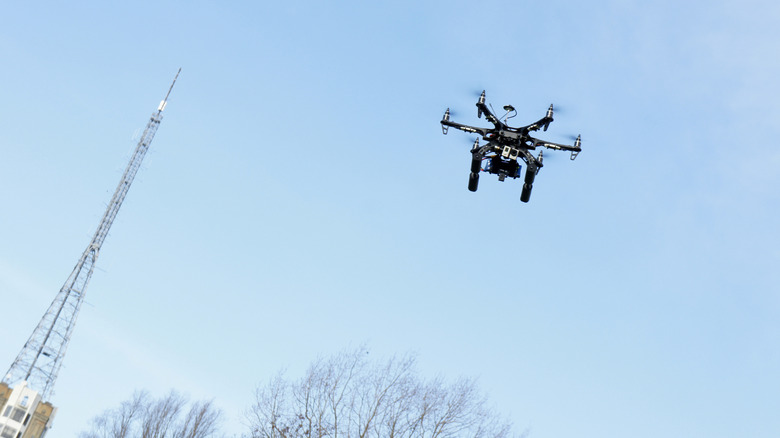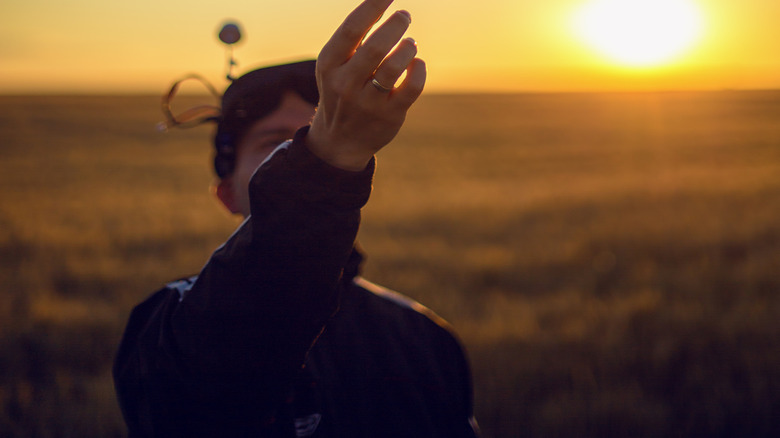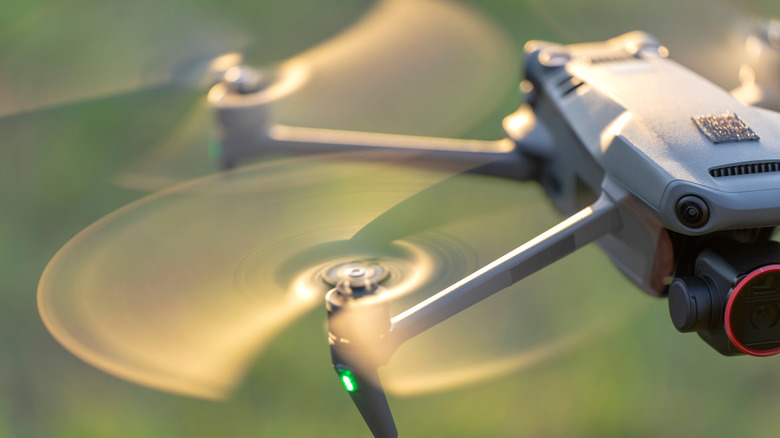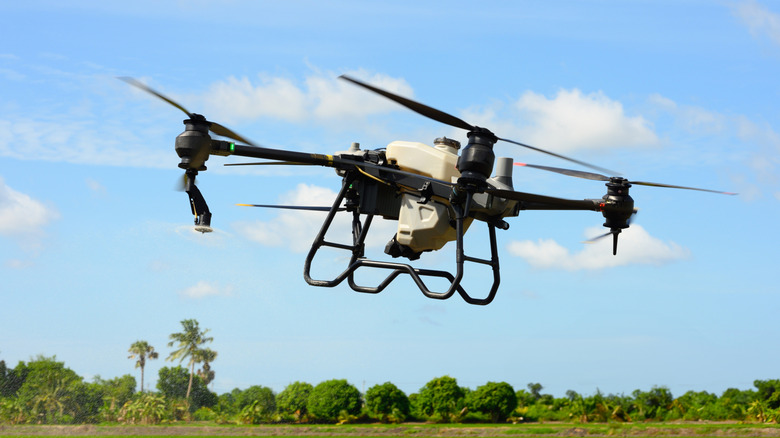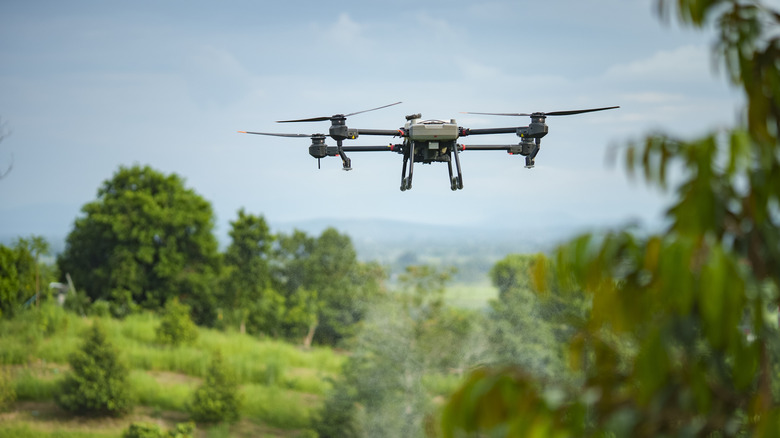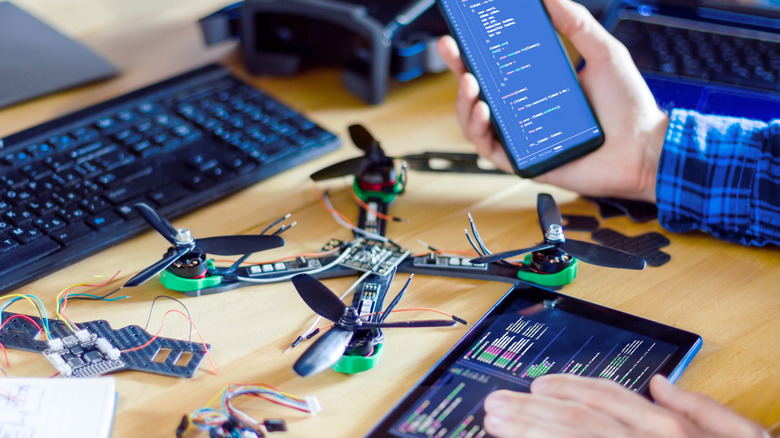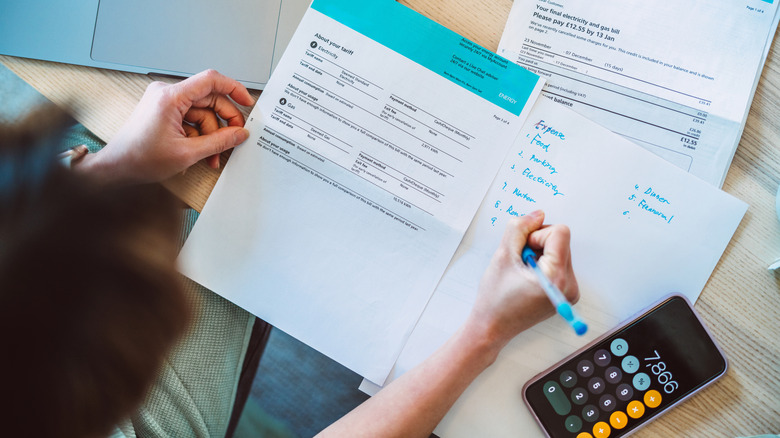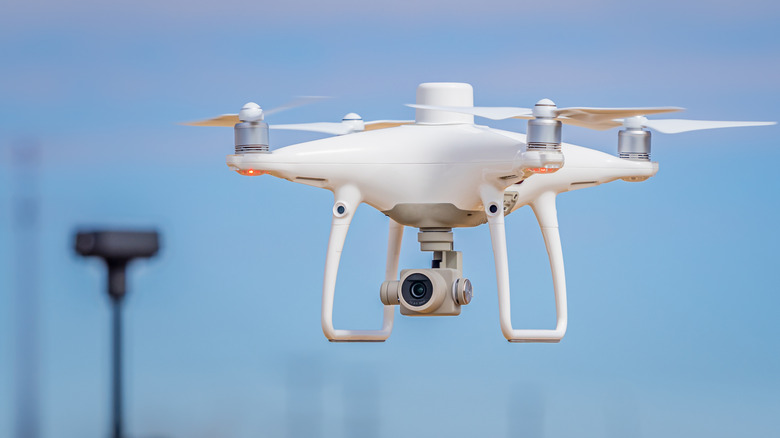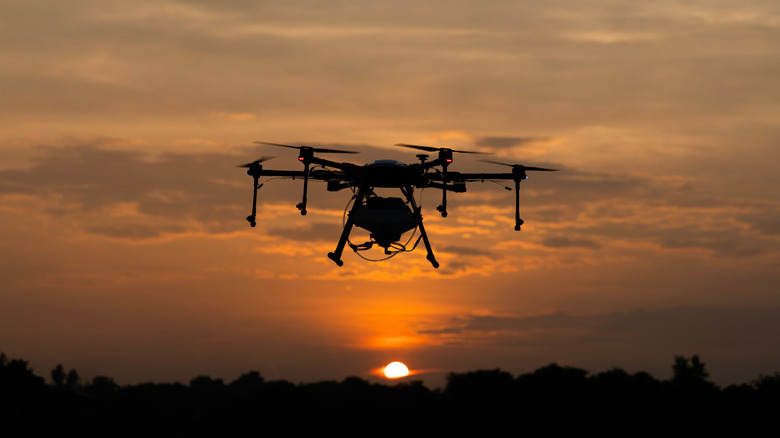10 Things You Should Know Before Buying A Drone (New Or Used)
Whether you use one for work or just want something cool to fly around on the weekends, there are a lot of benefits to owning a drone. United States military drones may break records, but there are plenty of options available to civilians that go above and beyond what you might need without costing a fortune. But whether you're buying new or used, you want to be sure you're not getting something that can't meet your needs, or getting scammed.
Every drone out there may seem like a sophisticated piece of technology, but each product comes with its own pros and cons. For instance, the DJI Mavic 3 Pro may review exceptionally well, but it also costs over $2,000 brand new, so it's important to know what features will do you the most good. Keep the following points in mind as you're perusing so that you don't spend too much or too little on a drone that may not even be that useful to you.
Battery life
It helps to know a thing or two about different drone batteries, whether you're buying a full drone or planning to design your own rig. Different options are available to keep the drone in the air while you operate it remotely, and each one has its unique strengths. For example, lithium batteries tend to be common in drones, but a LiFePO4 battery tends to be safer, as it has a highly reduced risk of combusting when exposed to extreme temperatures.
It's crucial to understand just how long your flight time will be with any given battery. You don't want to be out in the middle of nowhere and have your drone die on you without any way to reasonably recharge it. The DJI Matrice 300 RTK has a battery life of 55 minutes per charge, but a lot of cheaper options will only last a fraction of that.
And like with any electronic, a drone's battery will degrade over time, meaning it won't stay in the sky as long as was initially advertised. This is mainly an issue if you're purchasing a drone used, so it can help to fly it around for a bit to get a sense of where the battery's at. Plus, when you get a drone of your own, you should brush up on tips and tricks for maximizing your drone's battery life, like by regularly updating the firmware.
Warranty
If you buy a drone used, you won't get a warranty. That means you're liable for any replacements if the drone breaks, even if you did nothing wrong. Purchasing a drone from a reputable retailer means you have a little more protection, so you may want to consider buying a new drone for that reason alone.
Every drone brand comes with its own warranties, such as Skydio providing a one-year limited warranty on all of its products. This coverage only accounts for defects within frame and hardware. You won't get a new drone if it becomes damaged due to your actions, so it definitely pays to be mindful as you're maneuvering your drone at first.
If you want to be safe from those accidental collisions, it pays to look into extended warranty options. For instance, there's the Skydio Care plan, which provides additional coverage outside of the automatic limited warranty. That way, if you damage your drone within the specified timeframe, you can receive a replacement at a reduced or no cost. Similar extended warranties should be available for other brands, so it's handy to have in case you're not extremely confident in your drone-flying abilities.
Local weather
While the DJI M30 can withstand virtually any harsh weather, from rain to snow, it also costs thousands of dollars, which may be out of range for some buyers. Unless it specifies it can handle the rain, it's unadvisable to fly your drone in such conditions since the moisture could damage any of the electronic components.
As such, it's a good idea to think about what type of weather you generally see in your city. You may be able to stay inside when it rains, but you may be exposed to high winds pretty frequently and don't want to wait until a rare calm day to use your item. If you fall into that category, consider getting a heavier drone that won't get whipped around by the wind as much.
It's also ill-advised to fly your drone if it's below freezing (32 degrees Fahrenheit). You could catastrophically damage your drone if it's that cold out with a minimal dew point deviation. Your drone could develop ice on the propellers, meaning the motor has to work extra hard to make them work, eventually breaking it. Some drones are specially designed to handle this weather, but if yours doesn't come with that specification, you should wait until it's a nicer day to fly it.
Camera quality
One of the main reasons to get a drone is to capture aerial photographs and video footage. That means you don't just want to look at the battery and motor specs; you also want to be aware of whether the camera will take high-quality pictures to your liking. Uploading some shots to social media is one thing, but if you're a wedding photographer who wants to capture an entire venue or you have a similar professional need, you may want something a bit more resilient.
You want a drone camera with a suitable resolution and sensor size. Many drones process photos as DNG or RAW files, so you'll want to ensure your editing software is compatible with those. Fortunately, there are plenty of great drones for photographers that won't break the bank.
A photo is one thing, but capturing smooth, seamless video from a drone is another spectacle entirely. You've likely seen plenty of drone shots in movies like "Jurassic World" and "The Greatest Showman." Even if you're not working on a project on that level, you can definitely expand your filmmaking toolbox with a solid video drone. Even capturing aerial footage of a nearby city to use as an establishing shot can make your sizzle reel stand out. But again, that's dependent on having a good camera rather than something that only makes videos that look decent on Instagram.
Range
Whether you're capturing video or surveying land, you want to keep an eye on your drone at all times. If it gets too far out, you may never see it again. This is due to the fact every drone comes with a specific range it can still communicate with your controller. At a certain point, it'll lose that signal and come crashing to the ground, and even if you feel like scavenging through bushes and trees, you may have a hard time tracking it down.
You should know how far away you can fly your drone based on the packaging, but various factors can reduce overall range, too. If you're in less than ideal weather it can block or weaken the signal, and if the battery is on its last legs you may not be able to fly it as far. If you're unsure, some drone controllers offer a signal bar to visualize how strong the connection is. If it starts dropping, it's probably a good idea to bring the drone back to where you are.
Anyone seeking extra protection against losing a drone may want to consider at least adding an Apple Air Tag or similar tracker to it. That way if it does get lost, you have a better chance of getting hold of it again.
Local laws
Buying a new drone and taking it for a spin sounds like a lot of fun. And it is! However, you don't want your good time hampered by getting a fine because you failed to adhere to local guidelines on drone usage. There are numerous laws and regulations you need to be aware of before buying a drone so that you don't wind up with something you can't fly anywhere near you.
For starters, any drone that weighs at least 0.55 pounds that you plan on using within the United States needs to be registered with the Federal Aviation Administration. It only costs $5 per drone, and it's good for three years. It's also important to note that your registration number must be placed onto the exterior of the drone. But while that takes care of the federal mandate, there's still the matter of your state and city having their own drone laws.
For example, San Francisco requires drone users to first get the proper permits from the Recreation and Park Department before flying a drone in a city park. Your city may have fewer or more stringent drone laws, but you should brush up on them so that you don't find yourself always needing to go outside of town to use your device.
Additional tools
Depending on the type of drone you want to buy, you could wind up spending well over $1,000, and that may not even be the total investment. You may require additional software and accessories to get your drone to do everything you want, and all of that costs extra money.
As stated previously, photographers and videographers will need to input footage into software to edit. If you don't already have those, you'll need to sign up for a subscription. Adobe Creative Cloud tends to be the go-to for creatives, but you can probably find something cheaper out there. Even looking outside of software, if you plan on capturing a lot of footage all on one trip, you may also want to purchase several memory cards so you can store it all.
Lens filters can give videos a unique look, and landing pads help prevent dirt from getting kicked up into the propellers during take-off and landings. Strobe lights may also be a good idea if you plan on flying your drone at night, so other aircraft can see it. All of this is just the beginning of what accessories you may need. Nothing's saying you need to get absolutely everything, but you should be aware of what would most benefit you so that you have a better idea of how much your complete drone experience will cost.
Insurance
Think of all the fun you can have with your drone. You take it out in an open space, fly it around, maybe do some loop-de-loops, but then you accidentally smack someone's car or house. Heaven forbid, you may even accidentally hit a person with it. Drones may be small, but they can do quite a bit of damage. To protect yourself and your wallet, it would behoove you to acquire drone insurance before flying it anywhere.
Companies like BWI Fly, SkyWatch.AI, and more offer comprehensive aviation insurance plans so that you're covered. You want to get the most far-reaching coverage possible, and that includes both liability and hull insurance. Liability coverage protects you if you damage someone's property or hurt someone, and hull insurance is good if you need help repairing or replacing a damaged drone.
In the event you use your drone for commercial purposes, it may also be a requirement for you to have insurance. If nothing else, prospective customers will feel more at ease hiring you knowing that you have protections in place to cover any possible damage. This is also yet another expense to consider before buying your new or used drone in the first place.
Undisclosed damage from previous owner
Of course, buying a drone right out of the box means you can be reasonably confident there's nothing wrong with it. If there is, you have a limited warranty to fall back on. But plenty of folks want to save some money by purchasing their drone secondhand. There's nothing inherently wrong with this, but you definitely want to conduct due diligence before forking over hundreds of dollars for something that may be on its last legs, especially as it may already be out of its warranty.
One of the easiest ways to check if a drone is still viable is to take it for a test flight. You would test drive a used car before buying it, and a drone deserves the same attention. Make note of anything that feels off or unresponsive. It's also advantageous to determine how many hours the drone has been flown, as this will tell you how much longer the battery could feasibly last.
In some cases, the seller may not be particularly upfront about past damage and flight time or even outright lie about it. Some drone brands allow third parties to monitor flight time, such as DJI having the DJI Fly app. In case you're trying to purchase a used DJI drone, you can access this app and see how many hours the drone has been flown. All this information may give you a little more leeway to haggle on the price too, if nothing else.
Practice makes perfect
After you buy your new or used drone, don't rush out to test its limits. Even if you've flown drones before, you never know how much the one you just got will differ from other devices. As such, it's always a good idea to fly it around for some tests to see how it handles. Not only will this make you a better drone pilot, but you'll have far less of a chance of damaging the item once it's in action.
For starters, it's a good idea to take your drone into a wide, open field where there's almost no chance it'll hit something else. Before attempting anything too advanced, start with the basics. Maneuver your drone so that it ascends and then descends at 45-degree angles. Another neat technique is called the "top hat" where you move it straight up, then across, then back down. And while you should have a good idea of what the battery life and range should be, you can actually see what those are like in person.
These test flights are also a good opportunity to get a handle on the camera. You can see how the footage pans out later. Maybe you'll realize you need to fly it a lot smoother to get the video to look the way you want it. Either way, you set yourself up for a lot more success in the future by taking the time to learn how to maneuver your drone sooner rather than later.
